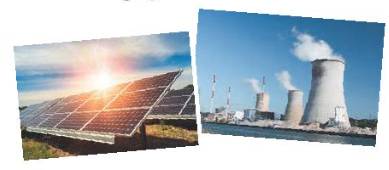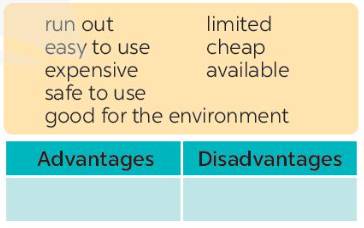Work in pair. Discuss the following questions.

1. What are the main energy sources in Viet Nam?
2. What type(s) of energy sources will we use in the future?
Work in pair. Discuss the following questions.

1. What are the main energy sources in Viet Nam?
2. What type(s) of energy sources will we use in the future?
Mr Lam is giving a lecture on energy sources. Read the text and choose the best option (A, B, or C) to complete the sentences.
Hello, class. Today I'd like to tell you about two energy sources. They are non-renewable sources and renewable sources.
Non-renewable sources are coal, oil and natural gas. We can use these sources to produce energy. They are cheap and easy to use. People use them a lot. But they are very limited and will run out soon.
Renewable sources come from the sun, wind or water. When energy comes from the sun, we call it solar energy. Wind energy comes from the wind, and hydro energy comes from water. Renewable sources are available, clean and safe to use. But they are expensive to produce.
In the future we will rely more on renewable energy sources. They are better for the environment and they will not run out.
1. Non – renewable sources are cheap and _________.
A. available
B. easy to use
C. expensive
2. _________come from the sun, wind or water.
A. Renewable sources
B. All energy sources
C. Non-renewable sources
3. When energy comes from water, we call it_________.
A. wind energy
B. solar energy
C. hydro energy
4. Renewable energy sources are better for_______.
A. the environment
B. our cars
C. hydro energy
Thảo luận (2)Hướng dẫn giải1. B
Non – renewable sources are cheap and easy to use.
(Năng lượng không thể tái tạo thì rẻ và dễ sử dụng.)
Thông tin: Non-renewable sources are coal, oil and natural gas. ... They are cheap and easy to use.
(Các nguồn không thể tái tạo là than đá, dầu mỏ và khí đốt tự nhiên. ... Chúng rẻ và dễ sử dụng.)
2. ARenewable sources come from the sun, wind or water.
(Các nguồn năng lượng có thể tái tạo đến từ mặt trời, gió và nước.)
Thông tin: Renewable sources come from the sun, wind or water.
(Các nguồn tái tạo đến từ mặt trời, gió hoặc nước.)
3. C
When energy comes from water, we call it hydro energy.
(Khi năng lượng đến từ nước, chúng ta gọi nó là năng lượng thủy điện.)
Thông tin: Wind energy comes from the wind, and hydro energy comes from water.
(Năng lượng gió đến từ gió, và năng lượng thủy điện đến từ nước.)
4. A
Renewable energy sources are better for the environment.
(Các nguồn năng lượng có thể tái tạo thì tốt hơn cho môi trường.)
Thông tin: In the future we will rely more on renewable energy sources. They are better for the environment and they will not run out.
(Trong tương lai, chúng tôi sẽ dựa nhiều hơn vào các nguồn năng lượng tái tạo. Chúng tốt hơn cho môi trường và chúng sẽ không cạn kiệt.)
(Trả lời bởi Hà Quang Minh)
Read the text again and answer the questions.
1. How many energy sources are there? What are they?
2. What do non-renewable sources include?
3. What are the advantages of renewable energy?
4. What will we rely more on in the future?
Thảo luận (1)Hướng dẫn giải1. There are two energy sources. They are non-renewable sources and renewable sources.
(Có hai nguồn năng lượng. Chúng là những nguồn không thể tái tạo và những nguồn có thể tái tạo.)
2. Non-renewable sources are coal, oil and natural gas.
(Các nguồn không thể tái tạo là than đá, dầu mỏ và khí đốt tự nhiên.)
3. Renewable sources are available, clean and safe to use. But they are expensive to produce.
(Nguồn tái tạo có sẵn, sạch sẽ và an toàn để sử dụng. Nhưng chúng đắt tiền để sản xuất.)
4. In the future we will rely more on renewable energy sources.
(Trong tương lai, chúng tôi sẽ dựa nhiều hơn vào các nguồn năng lượng tái tạo.)
(Trả lời bởi Hà Quang Minh)
Work in groups. Discuss and put the following words or phrases in the appropriate columns.

Thảo luận (1)Hướng dẫn giải(Trả lời bởi Hà Quang Minh)
Advantages
(Thuận lợi)
Disadvantages
(Bất lợi)
easy to use (dễ dàng sử dụng)
cheap (rẻ)
available (sẵn có)
safe to use (an toàn sử dụng)
good for the environment (tốt môi trường)
run out (cạn kiệt)
limited (có giới hạn)
expensive (đắt tiền)
Work in pairs. Ask and answer questions about the advantages and disadvantages of different energy sources.
Example:
A: What are the advantages of hydro energy?
B: It's available, clean and safe to use.
A: What are its disadvantages?
B: It's expensive to produce.
Thảo luận (1)Hướng dẫn giảiA: What are the advantages of energy from coal?
(Ưu điểm của năng lượng từ than đá là gì?)
B: It's cheap and easy to use.
(Nó rẻ và dễ sử dụng.)
A: What are its disadvantages?
(Nhược điểm của nó là gì?)
B: It's limited and not good for the environment.
(Nó hạn chế và không tốt cho môi trường.)
(Trả lời bởi Hà Quang Minh)